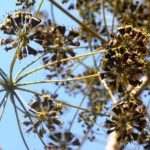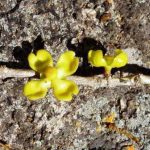TREE LIFE
OCTOBER 1990
MASHONALAND CALENDAR
Tuesday 2nd October: Botanic Garden Walk. Park your car at the Herbarium where we will meet Tom Muller at 1645 hours for 1700 hours.
Sunday 21st October: Kevin and Merle Grant will be our host and hostess on their farm ‘Mapere’ in the Barwick area. On our walk around a kopje we are sure to see signs of spring with trees in new leaf and perhaps flower.
Saturday 27th October: Walk with Mark at Cleveland Dam. This will be most interesting, so meet Mark in the car park at 1500 hours.
MATABELELAND CALENDAR
Sunday 7th October: A fun quiz at Hillside Dams. Route – along Sable Road and turn into Impala Road. Meet at “Bishop 3” at 0830 hours and after parking cars we will walk to the tree kopje. Afterwards back to John Bishop’s house for teatime and discussion and prize giving for ‘most improved beginner’ and others!! Bring tea and chairs.
Sunday 4th November: To Charles Stirling’s Mkondo Farm, 46.5km on the Victoria Falls Road, where we will meet up once again with Andrew Williams who is staying there. Varied trees along the 10km Umgusa River frontage and even Baikiaea plurijuga (teak for the uninitiated), and use of the farm homestead. An all day outing, meet at Falls Road Motors at 0830 – lifts already arranged.
MATABELELAND NOTES
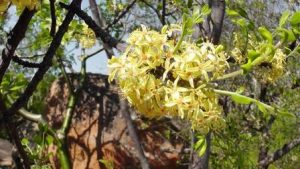
Ptaeroxylon obliquum. Photo: Brian Orford. Source: Flora of Zimbabwe
On Sunday, September 2nd we went to Gordon Park, the Scout Centre in the Matopos, where in a busy morning, in spite of many leafless trees, we identified some 78 species including Acacia fleckii, Acacia galpinii, Acokanthera rotundata, formerly schimperi, many Albizia tanganyicensis, the brown paper bark, Apodytes dimidiate, Brachylaena rotundata, flowering, Catha edulis, Combretum hereroense, Commiphora marlothii, the green paper bark, Cordia latissima, Euclea racemosa, Faurea saligna, Ficus abutilifolia, F. cordata, was pretoriae, then salicifolia, Homalium dentatum, many fine Kirkia acuminata, Mimusops zeyheri, Ochna pulchra, Olea europea, subsp. africana, Ozoroa insignis subsp. reticulata, many Pappea capensis, Parinari curatellifolia, a particularly fine specimen of a tree we do not see much, a good few Pseudolachnostylis maprouneifolia, Ptaeroxylon obliquum, Securidaca longepedunculata, Steganotaenia araliacea, Strychnos cocculoides, S. madagascariensis, S. matopensis, Tarchonanthus camphorates, a good sized tree, Tarenna zimbabwensis, Terminalia trichopoda, not T. stenostachya, as marked in about 1979, Vangueria infausta.
Gordon Park is a splendid area, both scenically and for trees. There must be many more species to be found when in leaf. Altogether a most excellent day.
-C. Sykes
DID HE MOSSEL PINKS ON SATURDAY? – read on – no typo
It was agreed the night before that we would leave for the Chirinda Forest at 0730 hours after our DIT breakfast. But the day started long before that, at about 0500 hours in fact, because that was when Ken started talking. Our departure was remarkably prompt but as our guide and host, Derek Rigden had a slight problem with the ‘check wagon’ it was agreed that the main party should move off and that we would rendezvous at a lay-by some 20km down the road.
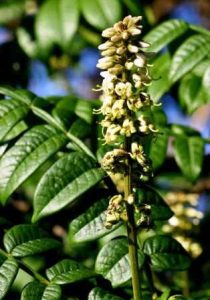
Bersama abyssinica. Photo: Bart Wursten. Source: Flora of Zimbabwe
What a splendid spot it was. Hanging on the edge of the mountain just above the main descent to Waterfall Junction it gave almost endless views to the East. Impromptu treeing started at once. Cussonia spicata, Syzgium cordatum, Phoenix reclinata were immediately spotted and from the under storey came Heteropyxis dehniae (not as pungent as the Matopos variety) a delicious Lippia smelling strongly of lemon and young Bersama abyssinica with its fascinating winged rachis. Derek soon joined us and an hour later, just as promised he led us into the Chirinda; a whole new world to those of us conditioned by drought in Matabeleland.
The sheer physical problem of just where and how to start, after all it is not that easy to snip a leaf sample from a 50m forest giant, found a three fold solution. Firstly, much of an earlier tree labelling and numbering was still in place, albeit weathered and chipped, and secondly we had B. Goldsmith’s check list of the Chirinda Forest to hand. This Maureen Silva Jones had up dated and amplified. It was an invaluable guide. Finally there was good and honest sleuthing.
We took the walk to the Big Tree before lunch and it was there that I found Maureen who asked if the leafy souvenir in her hand was a Didymosalpinx. I thought she was having me on and said so. She said “no” but that she was talking about No. 11 Didymosalpinx norae, named after Swynnerton’s wife. Maureen thinks she found No 11, but there was certainly no solution to the pronunciation of Didymosalpinx although several amusing suggestions were made.
Derek and Rose Rigden provided a sumptuous lunch which was washed down with the drink of one’s choice from the travelling bar. It was wonderful to be spared the time consuming chore of organising one’s own food. Afterwards some of us walked to the Valley of the Giants.
Many felt rather proud of their treeing achievements in the absence of experts, and I think first prize for sleuthing must go to Fiona Dawe for getting Zanthoxylum gilletii. I came away with 15 ticks on my checklist and after that I fear I reached saturation point. But I shall not forget Chrysophyllum gorungosanum or “stamvuug”. It is a splendid, soaring giant with a distinctive russet colour on the under surface of the leaves. We were lucky to find it in fruit. These are quite delicious and leave an after taste of Muscat grape in the mouth. Several members collected the seeds which resemble shiny brown beetles.
Some personal adventures are worth recording. Kevin Brennan got lost for two hours which is remarkable since none of the forest walks take more than fifteen minutes. I think he was hiding in the dense under storey of Dracaena fragrans watching his wife’s agitation. That he got lost again on the Tanganda River the next day convinced me that this was a common family diversion. Thora Hartley and her sister wandered out of the forest and into an unfriendly encounter with some locals. They wisely found their way back to the forest via a lantana thicket so their antagonists chose not to follow. Eileen Milton spent much of her time breaking traps and snares and Ian Milton had a bad fall which gave Ken an opportunity to practise painting with mercurochrome. We all heard the Samango monkeys and silver cheeked hornbills but few of us actually saw them.
Before we left the area there was an obligatory pilgrimage to Swynnerton’s memorial. This we found at the end of a very bad road and in a sadly neglected condition.
Back at Silverstreams that evening and in the convivial atmosphere of the pub, Derek and Rose gave us peri peri chicken and ‘special sadza’ followed by vinegar pudding. To cap it all Derek organised a quiz and the suggestion that Bulawayo should contest Harare was shouted down by one and all. I cannot remember which team won, but my daughter tells me that Dick’s mob took the laurels.
-Ian McCausland
D + 2 AT SILVER STREAMS
It is disconcerting to see a grown man crying. Well, Ian McCausland did not quite reach that stage, but his emotion was plain to see when he found Faidherbia albida growing in the Tanganda River Valley at Buffel’s drift. We all understood, we had all (with the possible exception of Maureen) become bemused by the repeated discoveries of trees which were complete strangers. The discovery of one to which we could relate was a delightful shock.
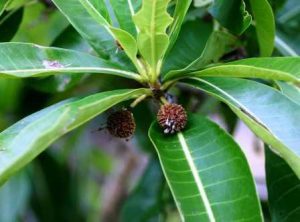
Breonadia salicina. Photo: Bart Wursten. Source: Flora of Zimbabwe
As soon as we had arrived there were cries of joy all round to discover Tabernaemontana elegans (Toad Tree) fruiting. This one was rather toothless, having shed its seeds, but Shirley Dodds found another later with a fine set of orange mandibles (if toads have such?). Breonadia salicina with glossy lanceolate leaves crowded at the ends of the branches was another “first” for many of us, as was Entada abyssinica still bearing the woody rims of disintegrated pods. Fiona Dawe found Ficus scassellatii and Ian McCausaland, now recovered, brought in Rhus chirindensis.
Stadmania oppositifolia gave itself away by its very asymmetric leaflets and outstanding mottled bark, but the big puzzle of the grey, smooth trunked Albizia with its prominent red-brown pods kept its secret until Mark Hyde tackled Bob Drummond on return to Harare. It turns out to be Albizia procera, a tree introduced to the tea estates as a shade tree but which has now escaped and settled down quite happily, thank you, along the roadside between Tanganda Junction and Waterfalls.
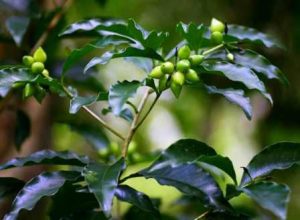
Peddiea africana. Photo: Bart Wursten. Source: Flora of Zimbabwe
After a refreshing drink laid on by the indefatigueable Rose and Derek Rigden and Trevor we moved on to the Chihonde River off Crystal Creek road. Although only 300 metres higher the vegetation took on a new look. Here we came across Diospyros whyteana, each highly polished leaf bearing a halo of delicate brown hair. Peddiea africana showed us its fibrous bark with strips a long way along the branches before breaking away. Collected also was Aphloia theiformis, Schefflera umbellifera, Ilex mitis and Drypetes arguta.
We lunched by the river and then walked upstream to look at the fascinating waterfalls. Collected on this walk was Sapium ellipticum and several interesting shrubs and herbs, Erica pleiotricha var. blaeriodes, Lindernia flava, and Vernonia wollastonii amongst them.
The general view of this day’s activities was that we had only skimmed the surface, and that a further full day at each site would be necessary in order to fully appreciate the great variety of plants that grow there.
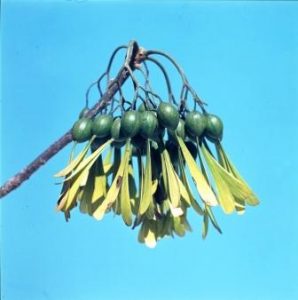
Gyrocarpus americanus. Photo: Mike Bingham. Source: Flora of Zimbabwe
P.S. Two of us spent an extra day at Silver Streams, but torrential rain the previous night had made the bush very uninviting. We decided therefore to go down to the Save River, not far from Birchenough Bridge, and were rewarded by finding Gyrocarpus americanus (fruiting), several Adenium multiflorum between two and three metres in height, all flowering, Azima tetracantha, with four spines at each pair of leaves, and several old friends from Tuli, Sterculia rogersii, Commiphora caerulea, Xanthocercis zambesiaca and Diospyros quiloensis.
This weekend was the most instructive and relaxing that any of us had spent for a long time, and words are inadequate to purvey our thanks to Rose and Derek Rigden for making it so.
LIST OF SOME INTERESTING SPECIMENS COLLECTED ON TREE SOCIETY VISIT TO CHIPINGE 11 – 13 AUGUST 1990
By layby on road between Silver Streams and Waterfall Junction VN c.673828, alt. c. 1160m
Heteropyxis dehniae Bridelia micrantha Bersama abyssinica
By Swynnerton’s Memorial, Mt Selinda :
Mellera lobulata (striking Acanthaceae, seen also very commonly in Chirinda Forest
By Tanganda River, Buffels Drift Estate, c. 493767 etc. alt 700m
Olax dissitiflora Acacia nilotica Artabotrys brachypetalus
Bridelia micrantha Breonadia salicina Crotalaria capensis
Entada abyssinica Erythrina lysistemon Garcinia livingstonei
Ficus scassellatii Ficus salicifolia Nuxia oppositifolia
Tabernaemontana elegans Trema orientalis Rhus chirindensis
Khaya nyasica Stadmania oppositifolia Maesa lanceolata
Deinbollia xanthocarpa Acacia nilotica Maclura africana
Maytenus undata Combretum microphyllum Albizia procera
In the afternoon, by the Chihonde River off the Crystal Road and on a walk upstream towards waterfalls, Alt. C. 1000m
Diospyros whyteana Catha edulis Peddiea Africana
Coffea ligustroides Ilex mitis Croton sylvaticus
Apodytes dimidiate Cussonia spicata Maesalance olata
Drypetes arguta Cassine aethiopica Ekebergia benguelensis
Myrica serrata Harungana madagascariensis Annona senegalensis
Macaranga capensis Aphloia theiformis Schefflera umbellifera
Bersama abyssinica Toddaliopsis bramekampii
Sapium ellipticum – alternate leaves, milky latex. Name suggested by Bob Drummond and a good match with specimens in the herbarium.
By the waterfall, at VN 679856
Lindernia flava (yellow fld. Trailing Scrophulariaceae)
Vernonia wollastonii
13 August 1990 – Roadside halt (not far from Buffels Drift) on way home, VN c.55-77-
Stereospermum kunthianum – in flower, very attractive
And another halt at VN c. 50-76-
Crossopteryx febrifuga – in fruit
-M. A. Hyde
NYARUPINDA CATCHMENT – AUGUST/SEPTEMBER 1990
With reference to Tree Life 127 we were “Under Milk Wood” outside REPS where Euphorbia ingens (great) has adapted itself to the wall, up which it grows – its stem has changed shape – it has become espalier like. The EUPHORBIACEAE or Spurge family is characterised by the milky latex it exudes, hence the name milkwood. What were the trees in the Welsh village about which Dylan Thomas wrote? Any suggestions?
The 26th August was a day of new experiences. It began with a striped Kingfisher doing his arm exercises to music – his own – high up on a Mfuti branch. The performance endeared this bird to me.
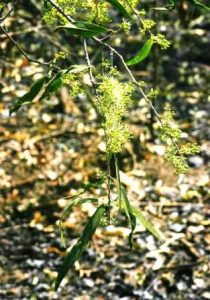
Boscia salicifolia. Photo: Bart Wursten. Source: Flora of Zimbabwe
What makes a tree trunk a startling neon yellow-green colour, evenly, all round, up to the canopy; is this colourful bark due to lichen or fungi? This tree is crowded by others in the woodland near the house where Kim took walkers on Tinto Tree Day. Does he remember seeing this novelty? This tree has remained anonymous until recently when the August winds blew down some new leaves and a froth of very small clusters of blossoms – pale green coloured. This tree is none other than Boscia salicifolia – a rare sight in flower because it is inconspicuous and often concealed by other foliage.
Another new bloom but not unexpected is that of Vernonia glaberimma, this shrub Genus Vernonia has female connotations in Tribal medicine … thank heaven for little girls!!
The next ‘first time of seeing’ was the beige flowers of Euphorbia decidua produced on fresh new stems amidst the flattened dried out branches which give this plant its name. The flowers are grouped in cyathia –special to EUPHORBIACEAE but not limited to that family. Acythium (scrabble or crossword) is a type of inflorescence. Homely examples of these are seen in Poinsettia and Euphorbia fulgens and Christ thorn. At this time the Euphorbia decidua flowers bore only male flowers. More news later about flowers with stigmas, if, when and where they appear.
The next surprise was finding freshwater sponges growing on green grass stems where the water is receding at the edge of the Nyarupinda dam. They are shaped like cotton on a distaff. Sponges belong to Porifera and they have sex lives. A new scene at this dam is the arrival of oxygen weed in prodigious quantities – this is called Elodea canadensis, no one knows where it has come from. It was not there last year. It should encourage the fish life – perhaps a fisherman introduced it – there is no doubt that it is doing very successfully – colonising the shores.
At midday birds were agitated by something in the Mfuti overhanging the garage. It was a Loris, a night ape, sitting up there almost hidden by foliage, its fur much the same colour as a Koala. Sunlight shone pink through one ear. Galago is the name for night ape, this is an African word from Senegal where these were first described. In Zimbabwe these animals frequent savannah woodlands especially Acacia and Mopane. Galagos do not need water and they also frequent dry water courses. Other tree associations favoured by them are Burkea-Terminalia, Terminalia-Combretum and to a lesser extent Brachystegia.
Acacias are favoured because boring beetles and storm damage cause these trees to exude gum. Also Acacias abound with insect life – larvae, and adults of weevils, moths etc. Galagos forage on the ground for termites. Gum is a favourite food for them. Africans believe that they are attracted to the garden by the fruit of the Muchenje trees nearby Diospyros kirkii. This is not true. This Loris has returned to this Mfuti hideout for several days. We have not seen it foraging soon after sunset or at dawn, not so active around midnight. When other night ape goes foraging she ‘parks’ her young, leaving them hanging from a branch.
-Benedicta Graves
Selebi-phikwe is a nickel mining town, an hour and a half’s drive from Francistown. I spent two weeks there recently, visiting family who have moved from Zimbabwe. I could not ignore the acacias, as I usually do, though there were plenty of other trees, few had leaves on.
Landing at Francistown we flew over acacias covered with white pompoms – Acacia mellifera, in full flower. There were only scattered clumps of them around Selebi, but standing in their midst, the fabulous scent was enough to keep at bay the sulphur dioxide smell from the smelter. A. tortilis is definitely king pin in the area. They seemed to come in every possible shape and size but were easily recognizable by their contorted pods and tiny leaflets. The Acacia nigrescens were just beginning to flower and there were one or two flowers on the A. erubescens – after much deliberation I decided they were A. erubescens and not A. fleckii and the petiole was longer than 1.3cm. There was also the odd A. nilotica and A. karroo.
Ten minutes drive from Selebi is the Motloutse River where everyone goes to picnic on a Saturday and Sunday – the 4 x 4 vehicles are pulled up side by side. It is 80 metres or so of sand, but surprisingly had a good flow of clear water meandering through it. There were always donkey carts filling up water containers and goats and more goats foraging along the banks. The river is lined with huge A. galpinii also just coming into flower. In a couple of these there were white backed vultures nesting. There were also some huge A. erioloba, with great inflated white thorns – exciting, as I had never seen those fat, furry, kidney shaped pods before. The spiny bushes, about a metre high, sparsely covered in yellow pompoms were, I think, A. nebrownii. They had small straight spines with dark tips and leaves with a single pair of pinnae arising between the thorns. Apparently they are also an indication of underground water. I certainly only saw them along the river, but always about 50 metres in from the banks.
There are some lovely kopjes right in Selebi, its just a matter of braving the piles of litter. One weekend we explored the Bobonong hills, between the Shashi and the Motloutse Rivers. The ‘In flight’ magazine on Air Botswana described them as being a continuation of the Matopos, but in fact they are no higher than the Selebi kopjes. On the hillsides Boscia albitrunca had leaves on, and so did Pappea capensis, while on the flat Maerua angolensis was noticeable by its heavy green foliage. The Albizia anthelmintica were in full flower, much to the delight of the bees and sunbirds. I was pleased to find a tamboti – Spirostachys africana, covered in old flower spikes, which looked like little Christmas tree candles. There was the occasional 3 lobed fruit developing at the base of a spike.
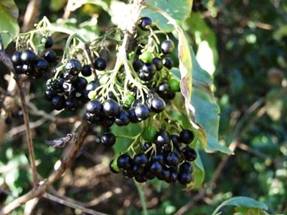
Pavetta eylesii. Photo: Rob Burrett. Source: Flora of Zimbabwe
Two discoveries for me were Ochna glauca and Pavetta eylesii. The few leaves left on the O. glauca were slightly serrated, blue green, folded along the midrib and they tended to droop. O. glauca and Croton gratissimus were the predominant shrubs on the kopjes. P. eylesii is the flaky bark pavetta – it certainly did have pale yellow flaking bark. It was covered with last year’s leaves, dry and beige, but still showing the bacterial nodules and had several fruiting heads with succulent looking black fruit.
Dodonea angustifolia seems to be the compulsory hedging shrub in Selebi. It trims well and the red and green seed capsules are very decorative.
-JB
MUKUVISI WOODLAND NOTES
Having been looking at FLACOURTIACEAE at the Botanic Garden, what then is the status of this family in the woodland? Poorly represented in both numbers and relative ecological importance : –
Our Dovyalis zeyheri comprises one of the last remaining populations near the city. In early years of conservation it crept timidly out of its refuge on termite heaps, but now does not seem to be spreading further. Soil conditions now maybe the limiting factor.
Flacourtia indica is as we usually see it, widespread but not very frequent. In the woodland I never see ripe fruit. Perhaps a question of not being up early enough in the morning. No. The fruit bats work the night shift.
Scolopia zeyheri is rare, I have only recorded two individuals, both on termitaria, both juvenile.
Dovyalis caffra is nearby and if those same fruit bats had worked a little harder they might have got seed into the woodland. For years I protected a thick and prickly hedge of this species not far away and the good old fruit bats were busy spreading seedlings, but unfortunately what passes as development has removed this colony. I did not envy the task of the man who had to cut out this rather thorny problem. It fought them right to the last few sprigs.
I do not understand the world wide distribution of FLACOURTICACEAE, it does not seem to be a typical Gondwanaland distribution, rather it seems to be more circumtropical. Certainly the range of F. indica from here to Polynesia is impressive.
As a casual observer can deduce from these notes I write monthly, I am mildly obsessed by the concept of Gondwanaland. Whenever I find myself gazing due south out of the False Bay/Cape Peninsula part of the continent, imagination makes me ponder how it was when that bit of the world that is now Antarctica sort of drifted South.
What a fantastic variety of life forms must have been obliterated in that gradual deep freeze process?
A similar kind of mental drift causes me now to think of another genus which seems to have an interesting Gondwanaland distribution.
Recently, whilst wandering round one of the northern suburbs, I met an extremely attractive red head. In an otherwise drab setting the creature looked exquisite, about six foot high and busy, brilliant scarlet flowers and looks to be close to Albizia. The kind of encounter which makes one think how come I have never encountered this plant before. Calliandra by name. Maybe I have passed this tree in crowded parks and gardens and never given it a second glance.
Species I think is C. haematocephala, from South America and the genus is not apparently found anywhere in Africa, but happens again in Madagascar and Asia. My imagination suggests to me that the genus first evolved in the proto Antarctica and spread laterally west and east after separation from Africa.
-G. Hall


